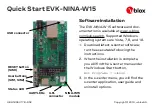EM0 Active
EM1 Sleep
EM2 Deep-
Sleep
EM3 Stop
EM4 Hiber-
nate
EM4 Shutoff
LEUART (Low Energy UART)
Available
Available
Available
-
-
-
I
2
C
Available
Available
Available
Available
-
-
ACMP (Analog Comparator)
Available
Available
Available
Available
-
-
PCNT (Pulse Counter)
Available
Available
Available
Available
-
-
LETIMER (Low Energy Timer)
Available
Available
Available
Available
-
-
WDOG (Watchdog)
Available
Available
Available
Available
-
-
RTCC (Real Time Clock)
Available
Available
Available
Available
Available
-
CRYOTIMER
Available
Available
Available
Available
Available
Available
Pin interrupts
Available
Available
Available
Available
Available
Available
TEMPCHANGE (Temperature Change)
Available
Available
Available
Available
Available
-
VMON Wakeup or Reset
Available
Available
Available
Available
Available
-
DCDC
Available
Available
Available
Available
Available
-
BOD/Power On Reset
On
On
On
On
On
On
Pin Reset
On
On
On
On
On
On
GPIO state retention
On
On
On
On
On
On
1
approximate time. refer to datasheet
2
HFXO can be kept running in EM2 DeepSleep
3
I2C functionality limited to receive address recognition
4
ACMP functionality limited to edge interrupt
5
Must be using ULFRCO
6
Pin wakeup from selected pins.
The different Energy Modes are summarized in the following sections.
9.3.1.1 EM0 Active
EM0 Active provides all system features.
• Cortex-M3 is executing code
• High and low frequency clock trees are active
• All peripheral functionality is available
9.3.1.2 EM1 Sleep
EM1 Sleep disables the core but leaves the remaining system fully available.
• Cortex-M3 is in sleep mode. Clocks to the core are off
• High and low frequency clock trees are active
• All peripheral functionality is available
EFM32JG1 Reference Manual
EMU - Energy Management Unit
silabs.com
| Smart. Connected. Energy-friendly.
Preliminary Rev. 0.6 | 159


















